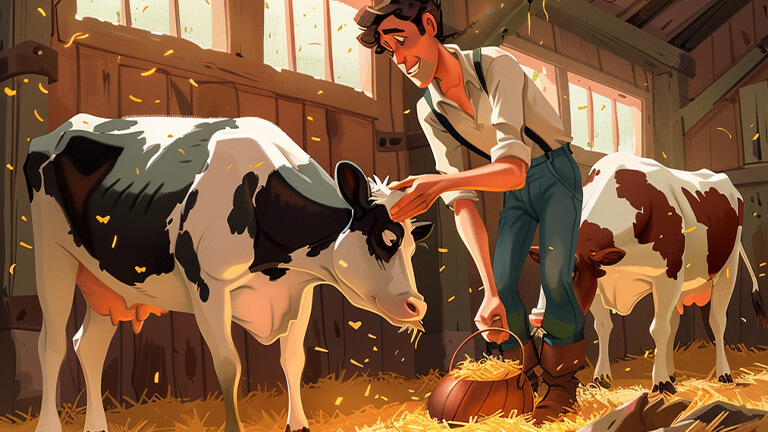Optimal feed ration #

For normal functioning of cattle, regular feeding is necessary in troughs in the barnyard or in the general trough of the barn. Feed can be stored in reserve for several days/months and, if necessary, the excess can be taken back.
An optimal feed ration ensures the maximum rate of weight gain in livestock and the volume of their production.
Deviation from the optimal diet leads to slower growth of the animal, decreased productivity and slower reproduction processes. In the complete absence of feed, livestock loses weight, does not produce products, and reproduction processes stop. Therefore, it is important to provide cattle with a balanced diet.
Attention! With very little or zero feeding of cattle, the animals weight will decrease. Cattle lose 1/3 of the weight they would gain with the optimal diet. An exception to this rule is individuals aged 421-480 days, which do not lose weight. If the weight drops down to 0 kg, the animal dies. You can also feed cattle with superfeed, which is a useful addition to the basic diet, but does not replace it.
Thus, it is important to provide cattle with adequate nutrition to avoid weight loss and animal death. Superfeed serves as an additional source of nutrition.
Feeding animals from 1 to 60 days #
Animals aged from 1 to 60 days (inclusive) are considered young animals. During this period, they gradually and evenly increase the consumption of all types of feed. The initial intake is 0.1 kg of each feed type on the first day, reaching the maximum level as indicated in the table on the last day of this period.
Comparable to consumption, animal weight gain also increases. Provided that the animals receive the optimal feed ration, the heifer will begin to increase its weight from 0.5 kg on the first day, reaching 13 kg on the last day, and the bull during this period will increase its weight from 0.5 kg on the first day to 16 kg on the last day.
Table. Maximum feed consumption on the last (60th) day with the optimal feed ration
| Resource | Bull (kg/day) | Cow(kg/day) |
|---|---|---|
| Milk | 8 | 8 |
| Compound feed | 10 | 10 |
| Lucerne | 6 | 6 |
| Turnips | 6 | 6 |
| Fodder beet | 3 | 3 |
| Swede | 3 | 3 |
| Oats | 3 | 3 |
Table. Increasing the weight of animals aged from 1 to 60 days, subject to receiving the optimal feed ration
| Day | Bull | Cow |
|---|---|---|
| 1 | 0.5 | 0.5 |
| X | \( W= 0,5 + 0.263(X-1)\) | \( W=0,5+0,212(X-1))\) |
| 60 | 16 | 13 |
Feeding animals from 61 to 240 days #
From the 61st day of life, cows and bulls are considered adult animals.
Animals aged from 61 to 240 days (inclusive) consume a constant amount of feed daily
Table. Feed consumption at the age of 61-240 days with the optimal feed ration
| Resource | Bull (kg/day) | Cow(kg/day) | |
|---|---|---|---|
| Compound feed | 45 | 35 | |
| Lucerne | 4 | 4 | |
| Turnips | 4 | 4 | |
| Fodder beet | 2 | 2 | |
| Swede | 2 | 2 | |
| Oats | 2 | 2 |
Provided cattle receive the optimal feed ration, a cow will increase its weight by 1.083 kg per day, and a bull by 1.583 kg daily. To reduce weight loss in this age group due to lack of staple food, superfeed can be used as a supplementary source of nutrition.
Feeding animals from 241 to 420 days #
Adult animals aged from 241 to 420 days (inclusive) consume a constant amount of feed daily, according to the table.
Table. Feed consumption at the age of 241-420 days with the optimal feed ration
| Resource | Bull (kg/day) | Cow(kg/day) |
|---|---|---|
| Compound feed | 40 | 30 |
| Lucerne | 3 | 3 |
| Turnips | 3 | 3 |
| Fodder beet | 2 | 1.5 |
| Swede | 2 | 1.5 |
| Oats | 2 | 1.5 |
With an optimal feed ration, the cow’s weight will increase by 0.275 kg daily, and the bull’s weight will increase by 0.4 kg daily. To reduce weight loss in this age group due to lack of staple food, superfeed can be used as a supplementary source of nutrition.
Feeding animals from 421 to 480 days #
Animals between 421 and 480 days old (inclusive) are considered old. They gradually and evenly reduce the consumption of all types of feed - from the maximum amount indicated in the table on the 421st day, and to 0.1 kg of each type of feed on the 480th day.
Table. Maximum feed consumption on day 421 with optimal feed ration for cattle
| Resource | Bull (kg/day) | Cow(kg/day) |
|---|---|---|
| Compound feed | 30 | 30 |
| Lucerne | 3 | 3 |
| Turnips | 3 | 3 |
| Fodder beet | 2 | 2 |
| Swede | 2 | 2 |
| Oats | 2 | 2 |
Animals aged 421-480 days no longer gain weight, do not produce milk and cannot mate. However, if a cow managed to mate before reaching 421 days, she will carry and give birth to offspring as usual.
It is useful to remember that at this age animals neithet gain nor lose weight, even if they remain hungry. Old animals can easily survive on pasture. You don’t have to feed them to keep them alive. However, if they are not fed, they will stop producing manure and the gestation period will increase. Therefore, to maintain manure production, it is still better to feed them additionally. Thus, old cattle require a special approach to feeding.